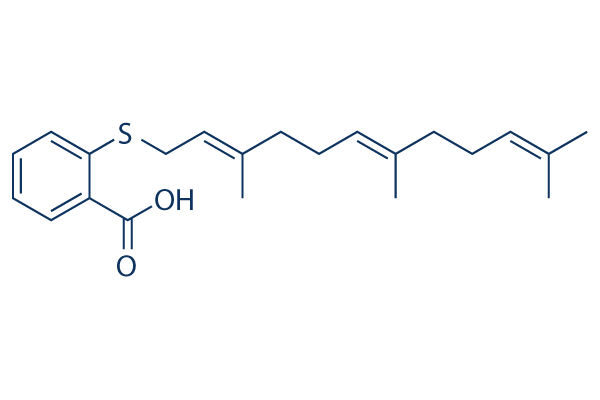| Cas No.: | 162520-00-5 |
| Chemical Name: | 2-((2E,6E)-3,7,11-trimethyldodeca-2,6,10-trienylthio)benzoic acid |
| Synonyms: | Salirasib |
| SMILES: | CC(=CCC/C(=C/CC/C(=C/CSC1=CC=CC=C1C(=O)O)/C)/C)C |
| Formula: | C22H30O2S |
| M.Wt: | 358.54 |
| Purity: | >98% |
| Sotrage: | 2 years -20°C Powder, 2 weeks 4°C in DMSO, 6 months -80°C in DMSO |
| Description: | Salirasib is a Ras inhibitor that inhibits specifically both oncogenically activated Ras and growth factor receptor-mediated Ras activation, resulting in the inhibition of Ras-dependent tumor growth. |
| Target: | Ki: 2.6 μM (PPMTase) |
| In Vivo: | Salirasib (40, 60 or 80 mg/kg, p.o.) significantly inhibits the tumor growth in a dose dependent manner in vivo[1]. Salirasib (5 mg/kg, i.p.) significantly decreases Ras expression in the dy2J/dy2Jmice, and causes an increase in Ras expression which is by far much lower than the increase observed in the dy2J/dy2J mice. Salirasib treatment is associated with significantly inhibition of both MMP-2 and MMP-9 activities in the dy2J/dy2J mice[2]. Salirasib (10 mg/kg, i.p.) inhibits tumour growth in a subcutaneous xenograft mice model without weight loss[3]. |
| In Vitro: | Salirasib (12.5-100 μM) inhibits the proliferation of ELT3 cells in a dose-dependent manner with an average IC50 of 58.57±4.59 μM. The effects of Salirasib on the TSC2-null cells are evidently mimicked by DN-Rheb but not by DN-Ras. Salirasib reduces Rheb in TSC2-null cells and TSC2 expression rescues the cells from the inhibitory effect of Salirasib. Salirasib reduces phosphorylation of S6K but not of ERK in the TSC2-null ELT3 cells[1]. Salirasib (50, 100, 150 μM) induces a dose- and time-dependent decrease of cell growth in HCC cells. Salirasib reduces cell proliferation through modulation of cell cycle effectors and inhibitors. Salirasib induces apoptosis in HepG2 and Hep3B cells. The growth inhibitory effect of salirasib in HCC cell lines is associated with mTOR inhibition independent of ERK or Akt activation[2]. |
| Cell Assay: | For time dependent response studies, cells are harvested with 0.05% Trypsin-EDTA daily for 1 to 7 days and counted under the microscope using the Trypan blue exclusion method.For dose response studies, cells are incubated in medium supplemented with salirasib or DMSO for 3 days. Cell viability is determined using a colorimetric WST-1 assay according to the manufacturer's instructions. The IC50 value, at which 50% of the cell growth is inhibited compared with DMSO control, is calculated by nonlinear regression analysis using GraphPad Prism software. |
| Animal Administration: | Six week old female athymic NMRI nu/nu mice are housed in filter-topped cages andreceive food and water ad libitum. Tumors are generated by subcutaneous injection into the right lower flank with 5×106 HepG2 cells suspended in 100 μL PBS in 12 mice. Two weeks after cell inoculation, when palpable tumours are established, mice are separated into salirasib-treated (n=6) and control group (n=4). Two animals do not develop tumours at that time point and had to be excluded from the study. They receive daily i.p. injections of 10 mg/kg salirasib or a similar volume of vehicle solution (PBS containing 2.5% v/v ethanol, pH 8.0) for 12 days. Tumor dimensions are recorded three times per week with a digital calliper starting with the first day of treatment. Tumor volumes are estimated as follows: V (mm3)=(length×width2)/2. Tumour weights are recorded at the time of sacrifice in order to evaluate treatment response. |
| References: | [1]. Makovski V, et al. Farnesylthiosalicylic acid (salirasib) inhibits Rheb in TSC2-null ELT3 cells: a potential treatment for lymphangioleiomyomatosis. Int J Cancer. 2012 Mar 15;130(6):1420-9. [2]. Nevo Y, et al. Chapman J. The Ras antagonist, farnesylthiosalicylic acid (FTS), decreases fibrosis and improves muscle strength in dy/dy mouse model of muscular dystrophy. PLoS One. 2011 Mar 22;6(3):e18049. [3]. Charette N, et al. Salirasib inhibits the growth of hepatocarcinoma cell lines in vitro and tumor growth in vivo through ras and mTOR inhibition. Mol Cancer. 2010 Sep 22;9:256. |

 DC Chemicals' products qualify for U.S. tariff exemptions. We guarantee no price increases due to customs duties and maintain stable supply, continuing to deliver reliable research solutions to our American clients.
DC Chemicals' products qualify for U.S. tariff exemptions. We guarantee no price increases due to customs duties and maintain stable supply, continuing to deliver reliable research solutions to our American clients.





















